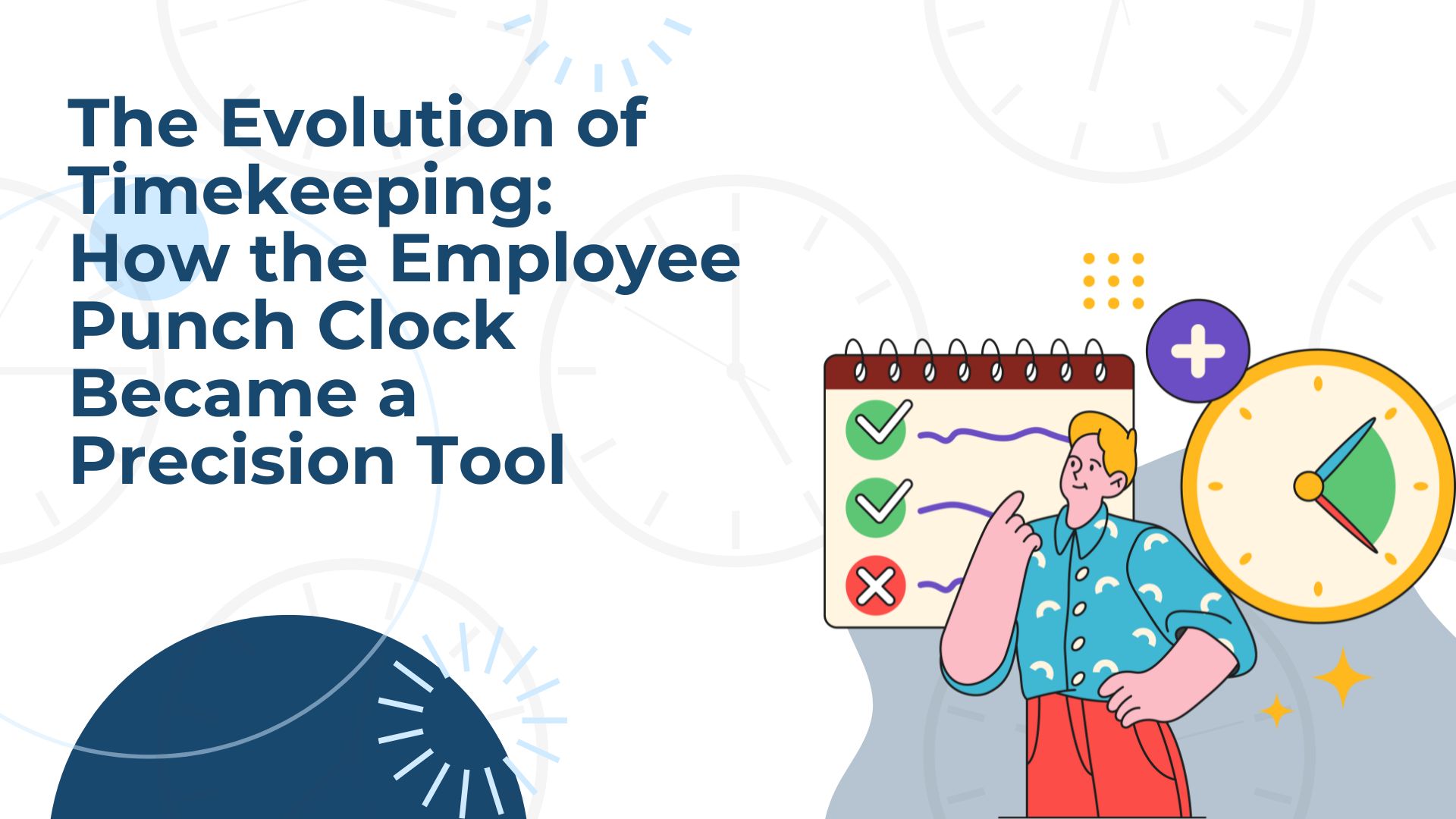In today’s fast-paced world of work, precision and efficiency are more than just buzzwords—they’re essential. As businesses shift toward data-driven operations and remote work becomes mainstream, the need for accurate time tracking has grown exponentially. Gone are when timekeeping meant manually signing attendance sheets or using clunky mechanical systems. The employee punch clock has now evolved into a digital, automated powerhouse that allows employers to track time to minute with minimal manual input.
This blog explores how the employee punch clock has transformed over time, its benefits to modern workplaces, and why it’s more than just a clock—it’s a strategic asset.
The Early Days of Timekeeping
The need to monitor working hours emerged during the industrial era as businesses sought ways to manage growing workforces efficiently. Employers needed a way to track how many hours their workers spent on the job. Traditional punch clocks, often mechanical, required employees to physically insert timecards, stamping them in and out as their shifts began and ended. These early employee punch clock systems were functional but prone to errors, manipulation, and inefficiencies.
Manual logging led to problems like time theft, buddy punching (when one worker clocks in for another), and inconsistent recordkeeping. Payroll processing became tedious, with HR teams spending hours verifying data and correcting mistakes.
The Digital Transformation of the Employee Punch Clock
Digital advancements have completely transformed how businesses track and manage employee hours. The employee punch clock evolved from a mechanical device to a sophisticated software-based system capable of doing much more than just recording hours.
Today’s digital employee punch clock systems include features like:
- Biometric authentication (fingerprint or facial recognition)
- Mobile accessibility for remote workers
- Cloud storage and real-time syncing
- Automated reports for payroll and compliance
- Geolocation tracking and geofencing
These systems offer unparalleled accuracy, allowing managers to track hours to the minute. The process is now seamless and requires almost no manual effort, freeing up HR teams to focus on more strategic tasks.
Why Precision Matters in Timekeeping
Accurate time tracking isn’t just about counting hours—it directly impacts payroll, compliance, and productivity. Today’s punch clock systems offer employers powerful tools to manage workforce time efficiently.
- Ensure fair compensation by paying for actual hours worked
- Avoid costly errors in overtime calculations
- Maintain compliance with labor laws and regulations
- Monitor remote or off-site staff without micromanaging
- Identify productivity trends and optimize workforce scheduling
When time is tracked precisely, business decisions are more informed, and employees benefit from greater transparency and trust.
Employee Punch Clock in the Remote and Hybrid Work Era
The shift toward flexible work arrangements, including remote and hybrid setups, has reshaped the modern workforce landscape. With employees working from multiple locations, time tracking presents new challenges. The digital employee punch clock addresses this head-on. Employees can now clock in and out using their smartphones, laptops, or tablets—no matter where they are. Employers can verify their location using GPS or biometric authentication to ensure accurate and secure time logs. This flexibility makes the employee punch clock invaluable in modern work environments, where physical presence is no longer the only marker of productivity.
How Employee Punch Clock Systems Improve Productivity
While some believe tracking work hours limits autonomy, today’s punch clock systems can boost overall performance and efficiency.
- Accountability Without Micromanagement
- When their time is tracked, employees are more conscious of how they spend it. It encourages employees to manage their time effectively, reducing the reliance on micromanagement.
- Better Task Allocation
- Managers can see how time is used across departments and assign tasks more effectively.
- Real-Time Data for Quick Decisions
- Instant access to data enables businesses to detect inefficiencies or slowdowns and respond with timely solutions quickly.
- Improved Focus
- Employees can better manage their workday when they understand their patterns through data from the employee punch clock.
The Role of the Employee Punch Clock in Payroll Automation
One of the most significant advantages of a digital employee punch clock is its integration with payroll systems. These tools can:
- Export timesheets directly into payroll software
- Calculate overtime, breaks, and absences automatically.
- Eliminate manual entry errors.
- Support compliance with wage and hour laws
This saves time and reduces the risk of legal issues and employee disputes.
Standard Features of Today’s Best Employee Punch Clock Solutions
If you’re considering implementing an employee punch clock system in your workplace, here are the must-have features:
- Mobile App Integration – For flexible clock-ins on the go
- Cloud-Based Storage – For secure and accessible records
- Facial Recognition or Fingerprint Scan – To prevent buddy punching
- Real-Time Reporting Dashboards – To keep managers updated
- Customizable Rules – For handling different roles, shifts, or break policies
- Automated alerts help ensure staff remember to log their hours accurately at the start and end of their shifts.
These features make the employee punch clock more than a time-tracking tool—it becomes a complete workforce management system.
How to Select the Ideal Time Tracking Solution for Your Workplace
When selecting a timekeeping system, it is essential to consider the following:
- Scalability: Will it grow with your company?
- Ease of Use: Is it intuitive for employees at all levels?
- Integration: Can it connect with your current payroll and HR software?
- Customer Support: Does the provider offer reliable service and training?
Brands like Clockify, Homebase, and TSheets (now QuickBooks Time) offer robust employee punch clock features suitable for small to mid-sized businesses.
Myths About Employee Punch Clocks – Debunked
Myth 1: They’re for large businesses.
Modern employee punch clock tools are also affordable and scalable for small businesses.
Myth 2: They hurt employee trust.
On the contrary, transparent tracking builds trust when used relatively and openly.
Myth 3: They’re Hard to set up.
Most systems can be implemented in days and require minimal training.
The Future of the Employee Punch Clock
The next wave of innovation in employee punch clock technology includes:
- AI-based productivity analysis
- Predictive scheduling tools
- Integration with employee wellness apps
- Voice-enabled check-ins
- Wearable tech sync (smartwatches, fitness bands)
As automation and data analytics become central to business operations, the employee punch clock will be pivotal in tracking time and improving work efficiency.
Timekeeping has come a long way—from mechanical punch cards to mobile, cloud-connected systems that track time to the minute. In this evolution, the employee punch clock has become an indispensable tool for the modern workforce. Whether your team is in-office, remote, or hybrid, this technology provides the accuracy, efficiency, and flexibility needed in today’s dynamic work environment. By embracing a digital employee punch clock, employers gain a deeper understanding of productivity, eliminate timekeeping errors, and create a more transparent and empowered workplace. After all, when every minute matters—tracking time precisely is no longer a luxury. It’s a necessity.
Sources:
- U.S. Department of Labor – https://www.dol.gov/agencies/whd/fact-sheets/21-flsa-recordkeeping





